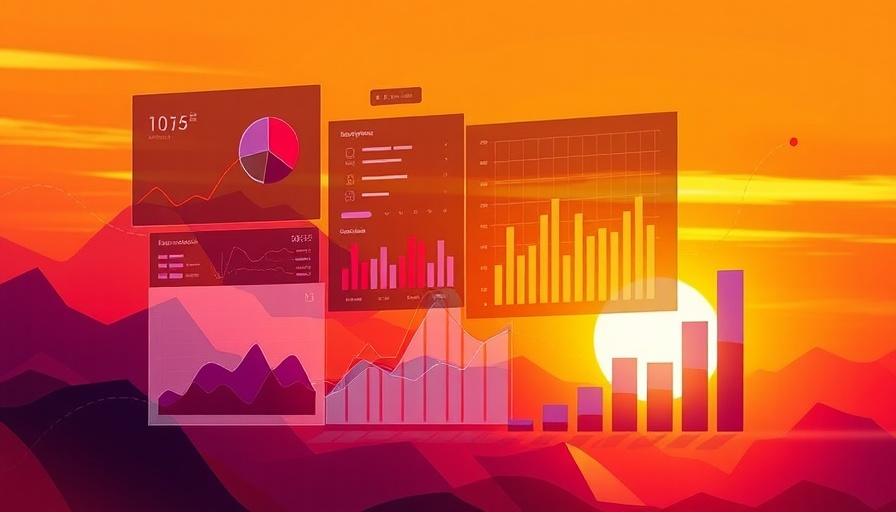
Maximalism in UI Design: A Bold Alternative to Minimalism
In recent times, the design landscape has seen a notable shift from minimalism to maximalism in user interface (UI) design, marking a bold statement about how brands express themselves through their digital presence. This colorful, layered approach to design contrasts sharply with the simplistic elegance of minimalism, inviting users to engage more richly with their visual environments.
What Is Maximalism in UI Design?
Maximalism in UI design embraces complexity, depth, and an abundance of creative elements. While minimalism often promotes a clean aesthetic, stripped of excess, maximalism dares to populate the screen with expressive colors, varied typography, and layered graphics. This design philosophy celebrates the motto of 'more is more,' effectively encouraging users to make a deeper connection with the content through vibrant visuals.
The Shift Away from Minimalism
The recent resurgence of maximalism can largely be attributed to the saturation of minimalist design in both digital and physical spaces. Initially popularized for its clean lines and simple usability, minimalism has led to a homogeneous visual environment that some users find uninspiring. The wane in enthusiasm for minimalistic interfaces has opened the door for a more playful and eclectic approach to design, reminiscent of nostalgic styles from the 90s and early 2000s.
Embracing Color and Texture
Maximalism isn’t just about crowded visuals; it emphasizes audacious color schemes, dynamic textures, and intricate patterns. Designers are encouraged to experiment with unexpected combinations, leading to an exhilarating user experience that fosters engagement. For instance, Zalando's new approach to product design integrates bold, collage-like visuals to evoke emotional connections with consumers. This playful aesthetic aligns with the desires of younger generations who seek authenticity and excitement over the sterile feel of minimalism.
Maximalism as a Marketing Tool
For professionals, business owners, and marketers, understanding maximalism's implications can be pivotal in shaping engaging brand identities. As digital marketing evolves, maximalist design elements can enhance brand storytelling and create distinctive digital experiences. Brands are using vibrant visuals and collages not just for aesthetic appeal but also to resonate emotionally with their audiences.
Trends Shaping Maximalism in UI Design
Several key trends are driving the maximalism movement:
- Rich Visual Storytelling: Brands harness the power of storytelling through vivid imagery and interactive elements that invite users to explore content in a layered manner.
- Emphasis on Personalization: Maximalist designs adapt to individual user experiences, allowing personalization that can enhance brand loyalty and engagement.
- Integrating Mixed Media: The use of videos, animations, and graphics creates a harmonious blend that captivates users and enhances their experience.
How to Implement Maximalism in Your Designs
Incorporating maximalist elements into your design strategy requires careful thought and creativity. Here are some actionable insights:
- Experiment with Color: Use a bold color palette, do not shy away from mixing contrasting hues that evoke emotional responses.
- Layered Textures: Combine different textures and materials to create a tactile experience that draws users in.
- Dynamic Typography: Play with varied fonts and sizes to create visual hierarchies that capture attention and guide users through content.
The Future of Maximalism in Design
As we move further into 2025, it's apparent that maximalism is here to stay in the web design realm. This trend reflects broader cultural shifts towards authenticity and personal expression. Expect to see more brands stepping away from standard aesthetics and towards immersive experiences that embrace individuality and emotional connections. The engagement strategies enabled by these creative approaches can lead to enhanced conversion rates and customer retention.
As you consider your next design project, embrace the vibrant energies that maximalism offers. The bold implementations of colors, patterns, and textures not only reflect current trends but also speak to the desire for realness and engagement in a digital world that craves connection.
Final Thoughts
Incorporating maximalist design into your digital marketing strategies not only distinguishes your brand but also resonates with consumers who are looking for authenticity and fun in their online interactions. Moving forward, consider re-exploring your designs with maximalist approaches to capture the ever-evolving market landscape.
To learn more about how to integrate these principles into your digital marketing efforts, consider reaching out to marketing consultants who focus on blending design with strategy. Your brand's visual presence is an invaluable asset in a competitive digital landscape.
 Add Row
Add Row  Add
Add 




Write A Comment